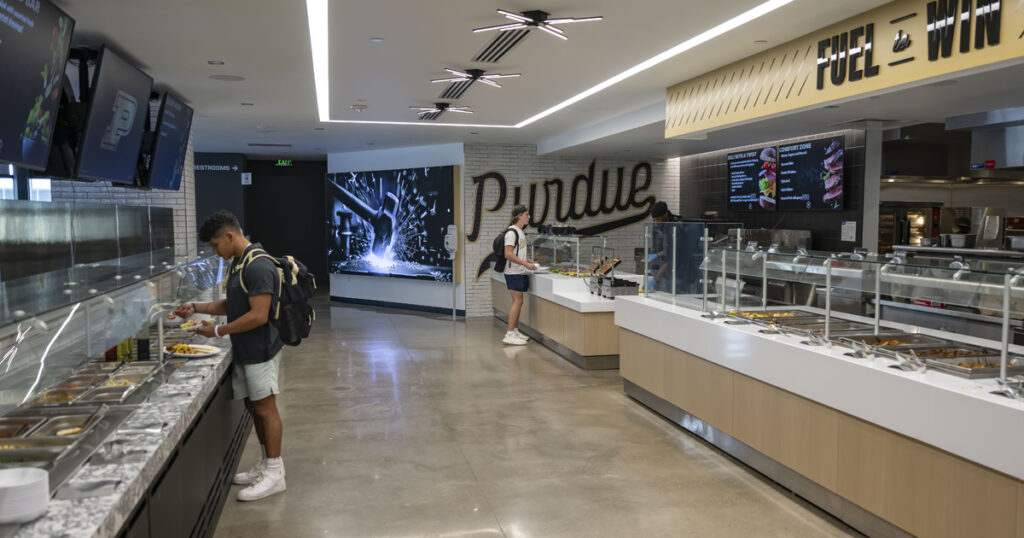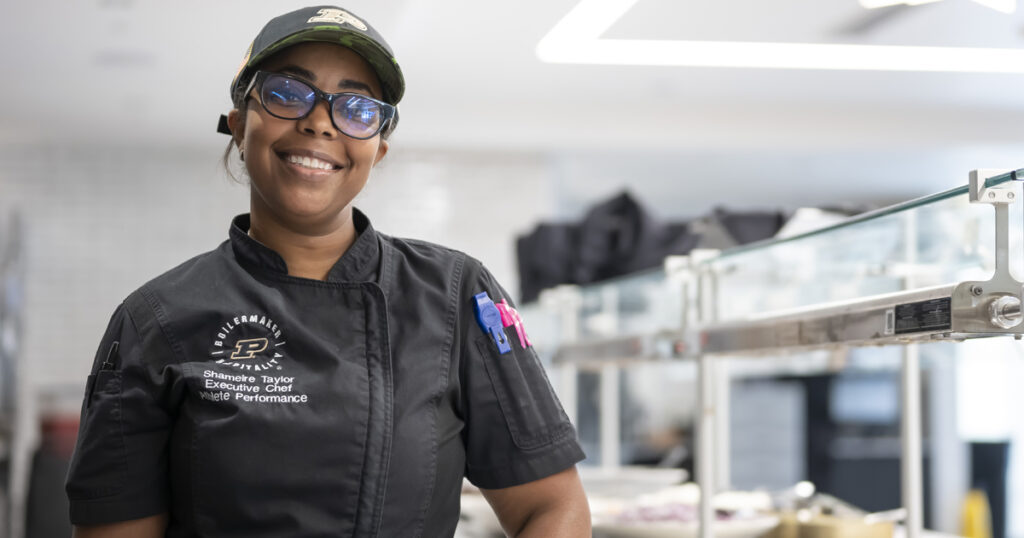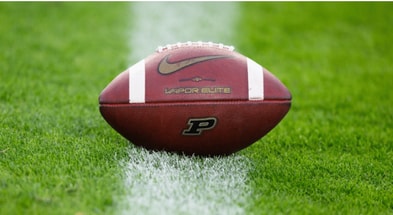Inside look at Purdue's new athlete dining facility

The doors to Purdue’s new dining facility open at 6 a.m., but chef Shameire Taylor and her staff have been in the building for nearly 2 ½ hours.
“No sleep for the weary,” said a smiling Taylor, who won’t leave until after 7 p.m. “I sometimes take cat naps in the office.”
There’s no wiggle room for Taylor and her staff at Purdue’s new athlete dining facility. The original plan was to arrive by 4:30 a.m., but adjustments were made.
“With the larger load, we upped our time to 3:30 only because some of our teams start really early,” Taylor said. “We needed to get a head start for those who wanted to knock the doors down to fuel and go weigh in, lift and then run to class.”
And when the doors open, Taylor’s staff is ready for the early arrivals and what happens the rest of the day.

As one of the elements of Phase 1 of the Ross-Ade Stadium renovation project, the athlete dining facility—which replaced the Purdue Team Store in the northeast corner—opened when coach Ryan Walters’ football team reported to training camp in late July.
It’s been busy since other teams started their seasons. Athletes from winter and spring sports are participating in offseason workouts but need to fuel their bodies. You’ll find athletes from nearly every sport inside the building daily.
More: Boiling Over | Bobinski on the state of Purdue athletics
“NUTRITION IS THE KEY”
The long overdue project, which cost $11 million, is the latest facility upgrade around the athletic department. It’s part of keeping Purdue competitive in recruiting and the transfer portal space against other schools, mainly in the Big Ten.
“From a functionality standpoint, it’s nice to have a space right across the street,” Walters said. “You can go get quality meals from our staff, who do a great job with variety and the quality of ingredients.
“Nutrition is the key. You’ve got to have the best quality of food and hydration because everybody else in the country also has it. That facility is definitely a step in the right direction in terms of competition in the recruiting sphere.”
However, taking care of the current athletes is the No. 1 goal. This is a one-stop location to ensure they’re meeting their nutritional needs as a segment of their overall training program.
“We have a phenomenal team that knows exactly what an athlete needs to perform at a higher level. This is championship caliber,” said Kyle Loudermilk, director of operations for Levy Restaurants, Purdue’s food service provider.
The location is ideal for the football program as it’s steps away from the Kozuch Performance Facility. Before this season, football players had their training table meals in the J. Nine Club on the west side of Mackey Arena.
Now, football players share tables with athletes from other sports, creating an opportunity to bring everyone together who may not have interacted in the past.
“The one thing I’ve noticed is the vibe is fantastic, and the energy is alive,” Loudermilk said.
PHOTO GALLERY: Athlete Dining Facility
Men’s and women’s basketball players will continue to have their training tables in the Wooden Club in Mackey Arena after practice and before games. Food is prepared in the dining facility and transported to Mackey Arena.
“It’s been awesome,” senior offensive lineman Gus Hartwig said. “It’s really convenient – you have a lot more space. We used to be at dinner at J. Nine and everybody was packed in there a little bit. Now you have more space to spread out.”
Breakfast runs from 6-10 a.m., followed by lunch from 10:30 a.m. to 2 p.m. Dinner begins at 4:30 p.m. and lasts until around 7 or 7:30 p.m., depending on practice schedules.
“We don’t turn anyone away,” Loudermilk said. “We want to make sure we’re feeding everybody.”
Loudermilk said breakfast and lunch have a steady flow, serving about 100 athletes an hour. But the challenge is keeping the line moving at dinner, with about 200 athletes coming through between 6 and 7 p.m.
The facility has 180 seats inside and additional space outside on a patio. Loudermilk said the tables usually change every 35-40 minutes.
“We’re at the mercy of when practices get out,” Loudermilk said. “We want everyone to dine in. We’re trying to build school spirit in addition to feeding them right. Success is driven by the smile on their faces. We want the entire experience to be positive for them.”
And it’s working.
“It’s sweet,” quarterback Hudson Card said. “It’s super nice on the inside. It’s more convenient for us. The food is great. Everything about it is upgraded a notch from what we had in the past.”
Eating healthy has always been at the forefront for Card, whose mother preached nutrition at an early age.
“I’ve always tried to eat healthy, but in college, especially when I’m trying to gain weight, it had to be a big part of my training,” Card said. “It makes me feel better and play better. I try to stay on top of nutrition and eating healthy for the most part.”
In 2021-22, Purdue spent around $3.2 million on athlete meals unrelated to team travel. According to the school’s NCAA revenue and expense report, that figure rose to $3.5 million during the 2022-23 academic year.
Top 10
- 1Hot
Kirk Herbstreit
Shot fired at First Take, Stephen A. Smith
- 2New
Ohio State vs. Oregon odds
Early Rose Bowl line released
- 3
Updated CFP Bracket
Quarterfinal matchups set
- 4Trending
Paul Finebaum
ESPN host rips CFP amid blowout
- 5
Klatt blasts Kiffin
Ole Miss HC called out for tweets
Get the On3 Top 10 to your inbox every morning
By clicking "Subscribe to Newsletter", I agree to On3's Privacy Notice, Terms, and use of my personal information described therein.
Purdue has increased its nutrition budget by an additional $1 million for 2024-25 to accommodate the new dining facility, according to an athletic department spokesperson.

WHAT’S ON THE MENU
Sushi, crab legs, and steak are in high demand. The football team had crab legs – Taylor ordered 10 cases – for their postgame meal after beating Indiana State. Last weekend, Taylor set up a homemade pasta station for the women’s soccer team after the Boilermakers beat Dayton.
Pizza is available every day, and the dough is made from scratch. Athletes can order a specialty pizza.
Taylor operates a scratch kitchen with dinner rolls, pasta, meatballs and soups along with gluten-free and vegetarian options. Fruits and vegetables are cut fresh and brought in from the athletes’ garden. Chicken and eggs come from Purdue Agricultural.
“It’s farm to table,” Taylor said.
Based on feedback, Taylor added breakfast pizzas and rice to the menu. Wraps are popular for breakfast, and smoothies provide plenty of nutrients on the go. Grab-and-go options and a hydration station are available at the front counter.
There’s a deli station, grilled panini sandwiches, hot comfort food, a taco bar, potato choices, and a frozen yogurt machine with two flavors. A long, colorful salad bar has just about everything. How about a vegan cookie?
Here’s what you won’t find – soft drinks – but plenty of Gatorade and sparkling water.
“They go crazy over it,” Taylor said of the sparkling water.
Taylor has been called the “queen of trickery,” adding healthy elements to otherwise sinful dishes. She served a chickpea dip cake and an avocado chocolate brownie.
“We couldn’t keep it on the shelf,” Taylor said. “They didn’t know it was avocado-based. We tricked them.”
And the peanut butter and jelly sandwiches aren’t boring.
“It’s a honey-whipped crunch. It’s phenomenal,” Taylor said. “It’s on a multi-grain bread with banana slices and toasted. We’re doing big things here at Purdue.”
Taylor has a staff of 25, all regular or part-time employees, but no university students are currently working in the facility.
“We’re understaffed,” Taylor said. “It’s crazy, but it’s service with a smile.”
Leftover food is currently being donated to the Lafayette Transitional Housing Center.

“SHE’S BEEN FANTASTIC”
Taylor’s culinary interests stem from her mother, who is Louisiana Creole and grew up in the kitchen making pastries and bread from scratch. She attended Oakland University and majored in psychology but had a background in hospitality and taught culinary arts. She also has experience in the healthcare industry.
She took that background and traveled to Paris to study as an intern for a year.
“I worked with sugar, chocolate, wedding cakes, croissants and baking bread,” Taylor said. “I wanted to cook, and I took that and ran with it, and I’ve been in culinary arts ever since.”
Taylor meets weekly with the dietician staff to review menus and receive feedback from the coaches. Taylor also interacts with the athletes as much as possible to gain their reactions.
“She’s been fantastic,” Loudermilk said. “She’s been with us for over a year, and she’s done a lot of amazing things before (the facility) was done. A lot of praise from the athletic department for everything she’s done.”
For Taylor, she’s warmly embraced the idea of preparing meals for nearly 500 athletes with one objective in mind.
“It’s a culture for me, and cooking is an experience, but it’s more to see what you’re putting out there is a winning mentality, and you are basically fueling them to go win championships,” Taylor said. “You’re a part of their process.”

























